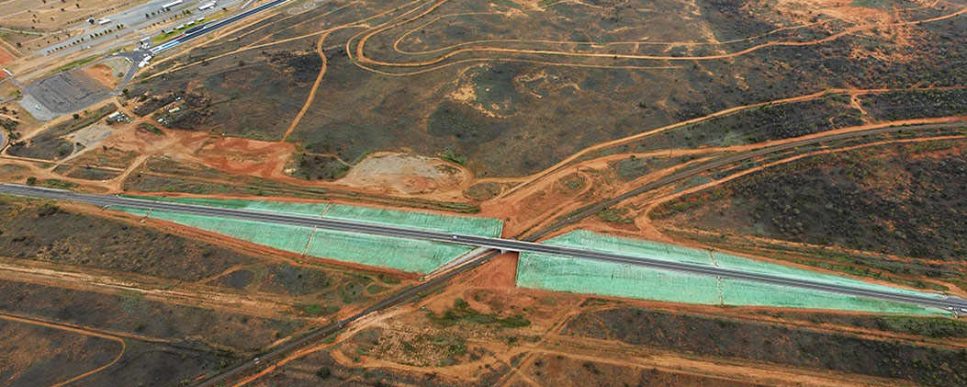
Hydromulching Solutions For Site Rehabilitation And Erosion Control

Successfully revegetating damaged landscapes following construction or mining activities can be partially difficult in the harsh Australian environment. Diverse soils, site and weather conditions across the country means that there isn’t a ‘one size fits all’ revegetation solutions for every site rehabilitation and erosion control project.
Regardless of this, hydromulching is widely recognized as one of the most efficient, environmentally friendly and cost-effective solutions for long lasting, healthy vegetation in Australia’s most punishing and remote areas. This seeding process – which is especially effective on large, hard-to-reach or sloping areas – utilises specially designed hydromulching equipment to spray a slurry of water, seed, fertiliser, organic mulch fibres and a binder/tackifier onto the seedbed. Specialized hydroseeders agitate the hydromulch mixture during application to ensure an even and constant distribution. This results in a more even application of the mix, protects the soil surface from erosion and also promotes faster, more unified seed germination.
There is often confusion about the difference between hydroseeding and hydromulching. It is important to remember that hydroseeding is simply a method of applying seed and does not offer erosion control until vegetation establishes. Hydromulching is a one-step process that has the added benefits specialized additives that stimulate faster and more sustainable vegetation growth that conventional hydroseeding techniques. Known as Growth Mediums, these organic mulches consist of soil builders and growth stimulants which act to replenish the topsoil with much needed nutrients and improve the soils ability to support long term growth, all while promoting erosion control and soil stabilisation. The composition of these Growth Mediums makes them extremely effective on even the most depleted soils.
Growth Mediums
Choosing the right Growth Medium for your hydromulching project will deliver the best revegetation results. After considering the sites unique needs, a thorough analysis of the soil is needed to determine what nutrients are lacking in the soil and what ingredients are needed for immediate topsoil development. This process is best to be carried out by soil rehabilitation specialists to avoid costly failures.
Hydraulic Growth Mediums (HGM)
A Hydraulic Growth Medium is the combination of seed, fertiliser, a cellulosic based mulch, tracking dye, and a tackifier or binder with the addition of fibre mediums such as straw or wood fibre. HGM’s are diversely capable growth medium products that can be applied to almost any site in need of revegetation. The advantages of HGM’s are the convenience of their application, either from a truck cannon for larger sites or basic hoses for smaller needs; their suitability to different sites, where HGM’s can be easily applied to either flat or sloped surfaces; and their component of microbiological agents that actively improve soil health and further ensure the longevity of the site’s revegetation.
Bonded Fibre Matrix (BFM)
Bonded Fibre Matrix products contain the same ingredients as HGMs but are applied at a much higher rate and contain a non-rewetting binder that is used as a means to create a stronger bond between the soils surface and the slurry. Essentially a heavy duty hydromulching growth medium, BFMs employ a combination of hydroseeding and hydromulching processes. By applying the hydroseeding solution first, followed by the BFM not only guarantees an excellent germination rate, but it permits the growth medium to be applied to almost any type of surface area through the addition of tackifiers to provide superior bonding performance. This is ideal for native seeds seed species as they are able to achieve high germination rates along with greater moisture retention overall and lasting erosion control.
Flexible Growth Mediums (FGM)
Flexible Growth Mediums, or Flexterra as it is often referred to, provides a cost-effective and safe alternative to conventional erosion control blankets that are prone to bridging and voiding. FGM’s are designed for sites with extreme conditions where HGM’s may not be the optimal solution. This may apply to sites with unusually arid conditions, severely sloped or uneven surfaces or particularly erosive soil conditions. Flexterra means that fine grading and extensive soil preparation such as topsoil and raking may not be necessary to achieve success, allowing the product to be applied through a hydroseeder during hydromulching applications for immediate performance. The blend also gives better protection to germinating seeds, allowing for dormancy through arid periods and ensuring the sustainability of your site’s rehabilitation. Labouring is reduced, safety and access concerns are diminished, while overall costs are reduced. Flexterra FGM can be applied quickly, even under wet conditions.
Choosing The Right Growth Medium For Your Site
Damaged and depleted soils require much more than the conventional hydroseeding treatments to achieve healthy and sustainable long-term growth. The addition of growth mediums during the hydromulching process provides moisture retention for faster germination, insulation from extreme temperatures, and protection from erosion. At the end of the day, you have faster, more sustainable, long-term growth that requires far less water and after-care.
What hydromulching growth medium or mix you choose for your site rehabilitation or revegetation project will ultimately depend on its unique requirements and environmental factors such as aridity, surface condition and erosive qualities.
Any hydromulching process should begin with an on-site soil analysis to best determine the custom blend of ingredients that will give your site the best chance of revegetation success. Determining which plant growth medium products best suit your site’s conditions and meet your project’s requirements is essential to their efficacy and sustainability.

